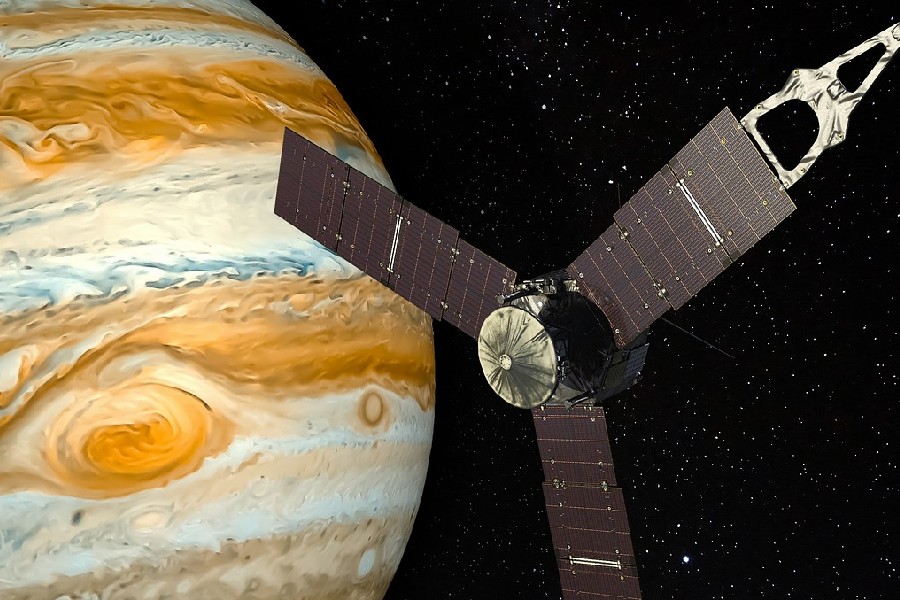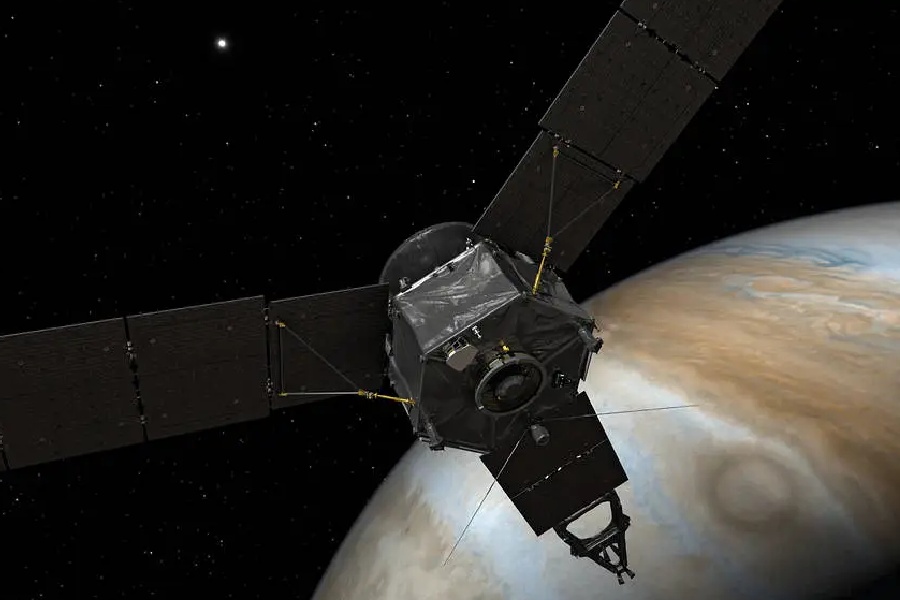The Juno NASA spacecraft has been revealing remarkable insights about Jupiter, the largest planet in our solar system. And its groundbreaking discoveries are far from over. The Juno mission timeline extends through at least 2025, with an option to continue observations through 2033.
Over the last several years, Juno has peered beneath Jupiter’s dense clouds and swirling storms. This has transformed our understanding of the gas giant’s interior structure, magnetic field, and formation history.
But how did we get to this point? Juno’s journey first began in 2011 with its launch from Earth. After traveling for five years across 1.7 billion miles of space, Juno finally entered orbit around Jupiter in 2016. This kicked off Juno’s science operations, as the probe began making close flybys of Jupiter every 53 days to collect data.
As Juno continues orbiting Jupiter, what other revelations lie ahead? Over the coming years, Juno may reveal more about Jupiter’s origins, atmosphere, magnetosphere, and even potential life in the clouds.

Juno Mission Timeline
The Juno mission, launched in 2011, is a NASA initiative focused on unraveling the mysteries of Jupiter. After a five-year journey, Juno entered orbit around the gas giant in 2016, marking a historic milestone as the first spacecraft to do so since Galileo.
Utilizing close flybys known as “perijove passes”, Juno gathers critical data on Jupiter’s atmosphere, magnetic field, and gravitational forces.
Equipped with advanced instruments, the mission aims to elucidate Jupiter’s origin and composition, contributing to a deeper understanding of the early solar system.
Pre-launch phase
Our understanding of Jupiter was limited before Juno. NASA sought to send a probe that could see beneath Jupiter’s dense clouds and unravel mysteries about its formation, interior, atmosphere, and magnetosphere. Juno would provide insights not possible with telescopes.
Development and construction of the Juno spacecraft
Juno was designed and built by Lockheed Martin. Its instruments would measure Jupiter’s gravity, magnetic field, atmospheric composition, and more. Juno’s orbit was designed to avoid intense radiation belts around Jupiter.
Solar panels powered Juno, and the spacecraft carried precise instruments to unveil Jupiter’s mysteries.
The spacecraft had a magnetometer to measure Jupiter’s magnetic field. It also had a microwave radiometer to see atmospheric structure and a gravity science experiment to map mass distribution. Juno’s camera would provide close-up views of Jupiter’s swirling clouds and storms.
Launch preparations and the journey to Jupiter
Juno launched aboard an Atlas V rocket on August 5, 2011. The launch went smoothly, sending Juno on a direct trajectory toward Jupiter. Juno received a gravity assist from Earth in October 2013, increasing its velocity. This five-year journey across 1.7 billion miles of space set the stage for Juno’s arrival at Jupiter.
Extensive preparations occurred before launch, including assembly, testing and fueling of the rocket and spacecraft. Numerous trajectory corrections kept Juno on course throughout its long journey. Juno’s speed increased to over 165,000 mph relative to the Sun as it neared Jupiter.
Arrival at Jupiter
Juno’s entry into Jupiter’s orbit
On July 4, 2016, Juno fired its main engine. This slowed the spacecraft down. It allowed Juno to be captured in Jupiter’s orbit. The 35-minute engine burn was critical to enter orbit successfully.
The insertion maneuver was precisely timed. It had to fire the engine when Juno was within just a few thousand miles of Jupiter. This allowed the planet’s gravity to capture Juno. If the burn was off by just a few minutes, Juno could have either crashed into Jupiter or rebounded back into space.
After a 35-minute burn, the engine shut off. Juno was now in a 53-day orbit around Jupiter. This transitioned Juno into science mode. Juno had successfully arrived at the giant planet after a long journey.
Entering Jupiter’s orbit allowed Juno to become the second spacecraft to orbit the gas giant. This marked the beginning of Juno’s science operations. Over the next 20 months, Juno would complete 37 close flybys to gather data and reveal Jupiter’s secrets
Initial observations and data collection
- First close passes – In late August 2016, Juno made its first close flyby of Jupiter. It passed within 2,600 miles of the cloud tops. All instruments were on to collect data. This marked the start of Juno’s scientific operations in Jupiter’s orbit.
- Early science results – Juno’s early observations proved successful. Juno sent back images of Jupiter’s poles for the first time. It also sensed ammonia in the deep atmosphere. These early results provided new insights about Jupiter.
Challenges and adjustments during the arrival phase
- Stuck helium valves – Prior to orbit insertion, two helium valves were stuck. This delayed the main engine burn. However, the issue was resolved quickly by the team.
- Entering safe mode – Shortly after entering orbit, Juno went into safe mode. This interrupted science operations temporarily. Juno later stabilized and resumed normal activities as the Juno team overcame this hurdle.

Extended mission and discoveries
Successes and challenges during the extended mission phase
Juno’s initial mission was planned to end in 2018 after completing 33 orbits. However, the spacecraft and instruments remained in good health allowing NASA to extend the mission through at least July 2021.
This extended phase has allowed further gravity measurements and perijove passes to build on Juno’s initial findings. Challenges have included dealing with Jupiter’s intense radiation environment which can cause glitches and resets of the spacecraft’s onboard computers.
Surprising discoveries and unexpected observations
During its extended mission, Juno made some unexpected discoveries about Jupiter’s atmosphere, poles, auroras and interior structure.
These include observing symmetrical vortex structures at the poles, detecting heavy metals like chromium and iron deeper in the atmosphere than expected, and mapping the 3D structure of Jupiter’s electric currents that drive the auroras.
Juno Scientific Objectives
Overview of the scientific goals of the Juno mission
The Juno mission has several key scientific goals focused on furthering our understanding of Jupiter. These include studying the existence of a solid planetary core, determining the amount of water present within Jupiter’s atmosphere, measuring the planet’s magnetic field accurately and mapping its polar magnetosphere.
Instrumentation on board for data collection
To meet its science objectives, Juno carries a suite of instruments for data collection, including a microwave radiometer. It probes beneath Jupiter’s clouds.
It also includes a magnetometer to measure the planet’s magnetic field. There are also plasma and energetic particle detectors, radio and gravity science systems, and various visible and infrared cameras.
Key questions the mission aims to answer about Jupiter
The instrumentation aboard Juno will gather the critical data needed to answer fundamental questions about Jupiter. These questions include determining if Jupiter has a rocky core and understanding the planet’s core mass.
Other questions involve measuring water abundance and investigating the structure and motion of Jupiter’s magnetic fields.
The findings from the data collected by Juno’s instrumentation will give us unparalleled insights into the formation and evolutionary history of our solar system’s largest planet.
Perijove Passes
The perijove passes refer to when the Juno spacecraft comes closest to Jupiter during its elliptical orbit. These passes allow Juno to fly within a few thousand miles of Jupiter’s cloud tops to collect valuable scientific data.
The perijove passes are significant as this is when Juno is best positioned to take measurements, gather images, and detect variations in Jupiter’s gravitational and magnetic fields.
Detailed accounts of select perijove passes
During its second perijove on July 11, 2016, Juno passed about 2,600 miles above Jupiter’s clouds. It captured stunning images of the planet’s poles, detected emissions from Jupiter’s auroras, and began surveying Jupiter’s gravitational field.
On its third perijove in August 2016, Juno successfully turned on its microwave radiometer instrument to start probing Jupiter’s atmosphere.
Scientific findings and discoveries during perijove passes
Key discoveries from Juno’s perijove passes include observations of clusters of cyclones at Jupiter’s poles. Other key discoveries include findings on the planet’s asymmetric magnetic field and data on the abundance of ammonia and water in Jupiter’s atmosphere.
Juno has also mapped Jupiter’s gravity and magnetic fields in unprecedented detail, furthering our understanding of the planet’s interior structure and magnetosphere.
Impact of Juno’s Findings on Our Understanding of Jupiter and the Solar System
The insights gained from Juno have tremendously improved our understanding of gas giants and reshaped models of Jupiter’s formation and evolution.
Its observations have implications for the habitability of icy moons like Europa and Ganymede. Juno has also revealed new information about Jupiter’s atmospheric composition, weather patterns, gravitational field and magnetosphere.
Conclusion
We hope this exploration of the Juno mission timeline has provided greater insight into this pioneering Jupiter orbiter. From its launch in 2011 to the critical orbital insertion in 2016, Juno has completed key milestones in its journey to Jupiter.
Across its prime mission and extended phases, Juno has completed groundbreaking science and transmitted stunning images.
As Juno continues to peer beneath Jupiter’s turbulent clouds during additional flybys, we look forward to new revelations about the gas giant’s atmosphere, magnetic fields, moons, and internal structure.
The insights gained from Juno’s extensive exploration of Jupiter will have lasting impacts on our understanding of the solar system’s largest planet. This article has illustrated the key milestones, maneuvers, and discoveries that have made the Juno mission such a success and contributed immensely to planetary science
